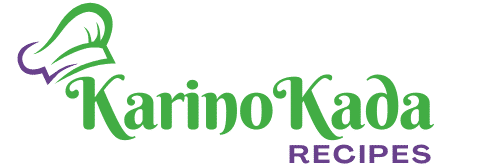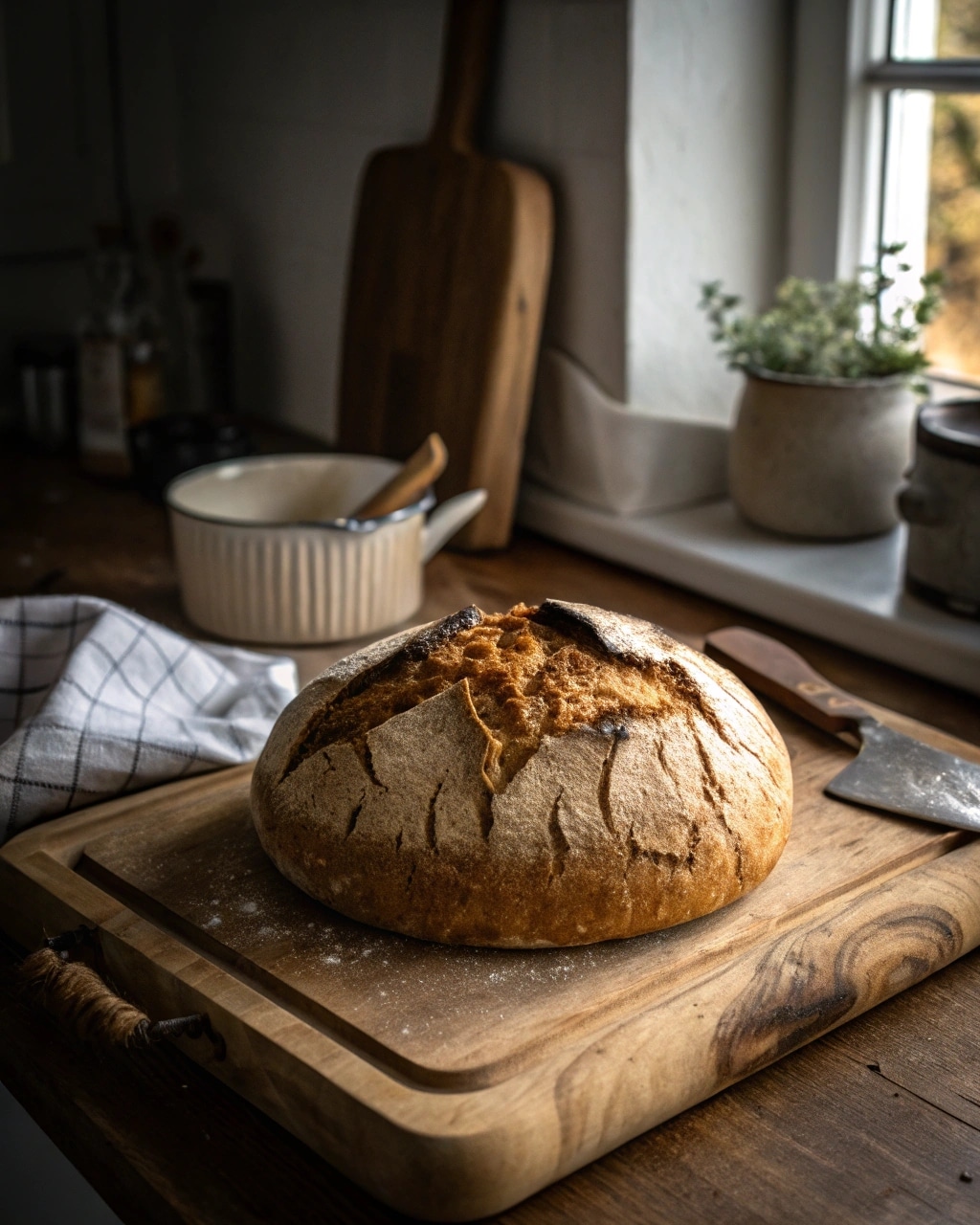Warm, rustic, and slightly nutty—this einkorn sourdough bread recipe is one of those beautiful reminders that simplicity can be deeply satisfying. In this guide, I’ll show you how to make a loaf that’s crusty on the outside and tender inside, using ancient einkorn wheat. It’s a flour I return to often—not only for its delicate taste, but for how gently it echoes my roots.
Growing up in Kyoto, the kitchen was where stories were told without words. My grandmother’s hands taught me that patience is the quiet secret in every good recipe. I still remember the first time I opened my wooden recipe box here in California and found her handwritten note for sourdough—written when einkorn was just “flour.” This version It blends traditional techniques with a touch of California style.
If you’re curious whether you can use einkorn for sourdough (spoiler: absolutely), or looking for a clean, foolproof einkorn sourdough bread recipe, you’re in the right place. You’ll get step-by-step instructions, ingredient details, and tips that will help you bake a bread that feels like home.
Ingredients for Einkorn Sourdough Bread
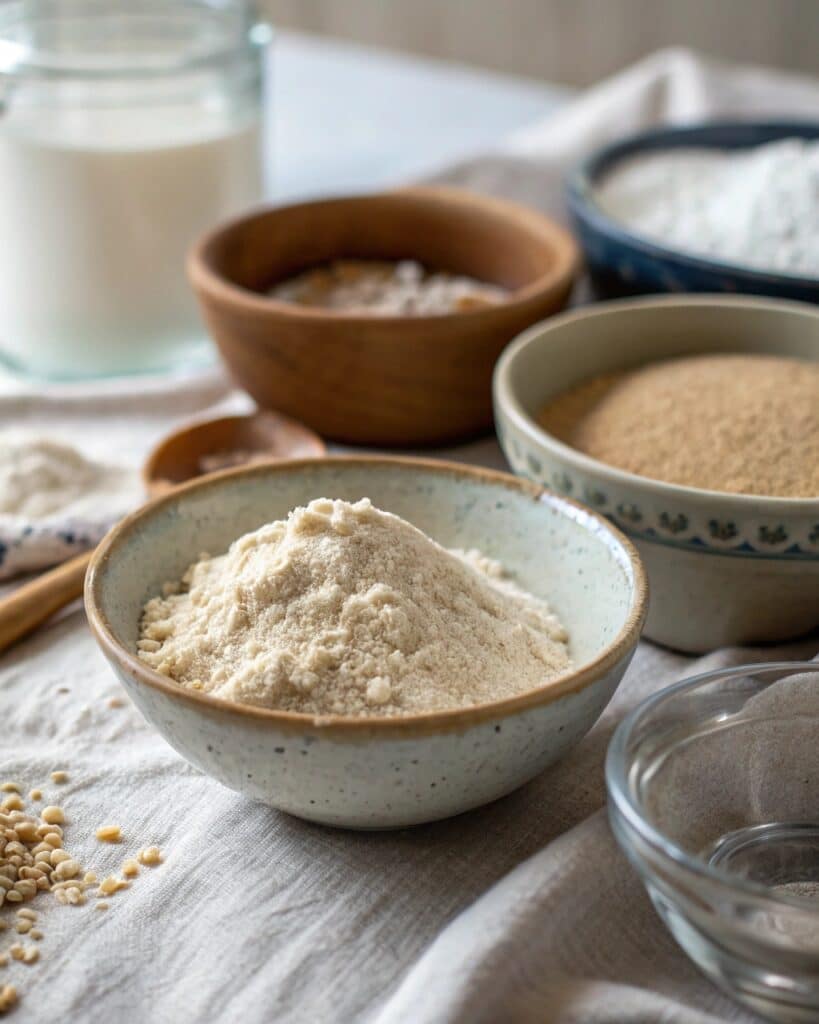
What you’ll need for a hearty, reliable loaf
Here are the ingredients you’ll need for a single round loaf made with 100% whole grain einkorn flour. Note: Einkorn absorbs less water than other flours, so hydration is slightly lower than traditional sourdough recipes.
| Ingredient | Quantity |
|---|---|
| Whole Grain Einkorn Flour | 500 g (about 4 cups) |
| Filtered Water | 325 g (about 1⅓ cups) |
| Active Sourdough Starter (100% hydration) | 100 g (½ cup) |
| Sea Salt | 9 g (1½ tsp) |
Optional Add-Ins:
- 1 tsp honey for slightly more rise
- 1 tbsp olive oil for a softer crumb
You’ll find similar ingredient ratios in my Ezekiel bread recipe, which also works beautifully with ancient grains.
How to Make Einkorn Sourdough Bread Step by Step
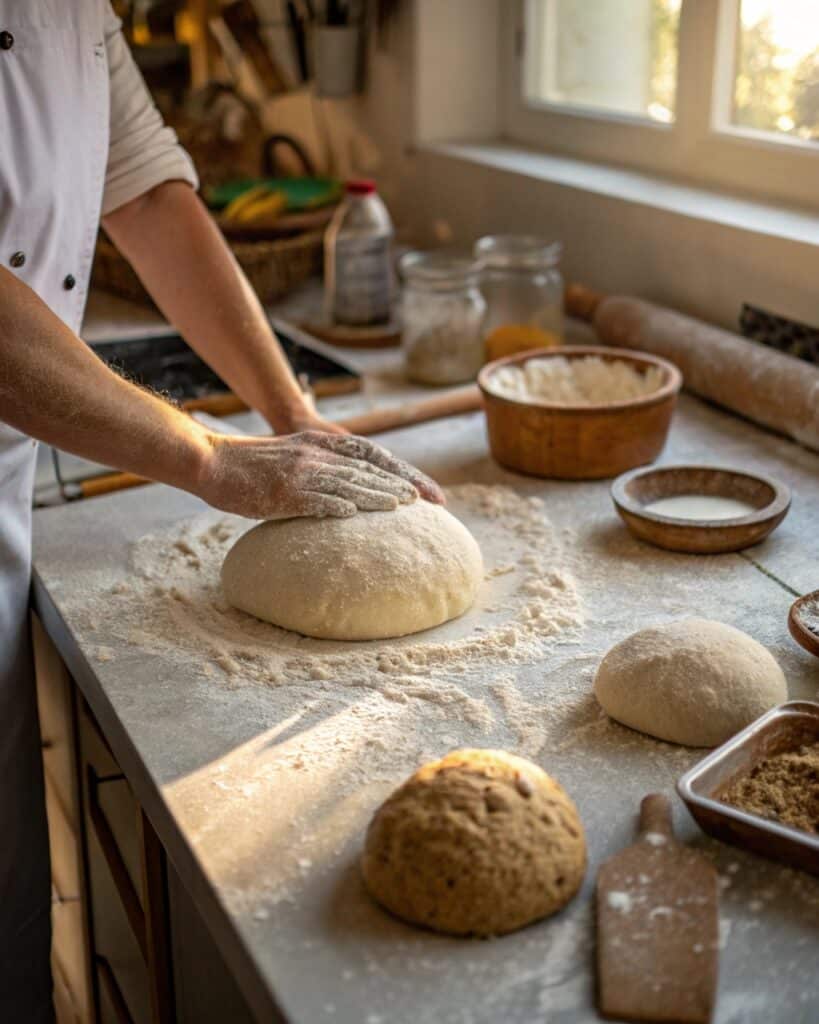
Gentle hands, slow rise, and simple techniques
This einkorn sourdough bread recipe doesn’t require any fancy folding routines or high-maintenance steps—just patience and trust. Einkorn behaves differently than modern wheat, so forget what you know about stretch-and-fold; here, you mix gently and let time do the work.
Let’s walk through the process together.
1. Feed your starter (6–8 hours before mixing):
Make sure your sourdough starter is active, bubbly, and has doubled in size. You’ll want it at peak strength when you mix the dough. If you’re unsure what that looks like, you might find helpful cues in the rise and feel of dough from my Amish cinnamon bread recipe, though that one uses commercial yeast.
2. Mix the dough (autolyse + salt later):
In a large bowl, mix:
- 500 g einkorn flour
- 100 g sourdough starter
- 325 g water (hold back 25 g if your dough feels too wet)
Stir the ingredients gently using a fork or wooden spoon until everything is fully mixed. Einkorn dough will be soft, sticky, and shaggy—that’s normal. Let it rest, covered with a damp towel, for 45 minutes.
3. Add salt:
Sprinkle 9 g sea salt over the dough and use your fingertips to lightly fold and knead it in. This step helps tighten gluten just enough for einkorn to hold structure.
4. Bulk ferment (4–5 hours at 70–75°F):
Let the dough rest at room temperature for about 4 to 5 hours. Every hour, gently fold the dough in the bowl from edge to center. It won’t stretch far—don’t force it. Einkorn tears easily, so be gentle. The dough should puff up, not necessarily double.
5. Shape and rest:
Flour your hands and a work surface. Turn the dough out, shape it into a round or oval loaf, and place it seam-side up in a well-floured banneton or towel-lined bowl. let it rest Cover the dough for 20 to 30 minutes.
6. Cold proof (8–12 hours):
Refrigerate overnight to develop flavor and make the dough easier to handle. The dough may not rise dramatically in the fridge—that’s okay.
7. Bake:
Preheat your oven to 475°F (245°C) with your Dutch oven inside. Carefully place the dough on parchment paper, score the surface with a sharp knife or lame, and move it into the hot Dutch oven.
- Bake covered for 25 minutes.
- Remove lid, reduce heat to 450°F, and bake another 15–20 minutes until deep golden brown.
8. Cool completely before slicing:
The crust will be crisp, and the crumb tender. Let it cool for at least 2 hours so the interior sets properly.
If you enjoy this rustic feel, you might also love the way texture and flavor develop in this Ocean Spray cranberry bread recipe, which follows a similar slow-rise rhythm.
How to Serve Einkorn Sourdough Bread
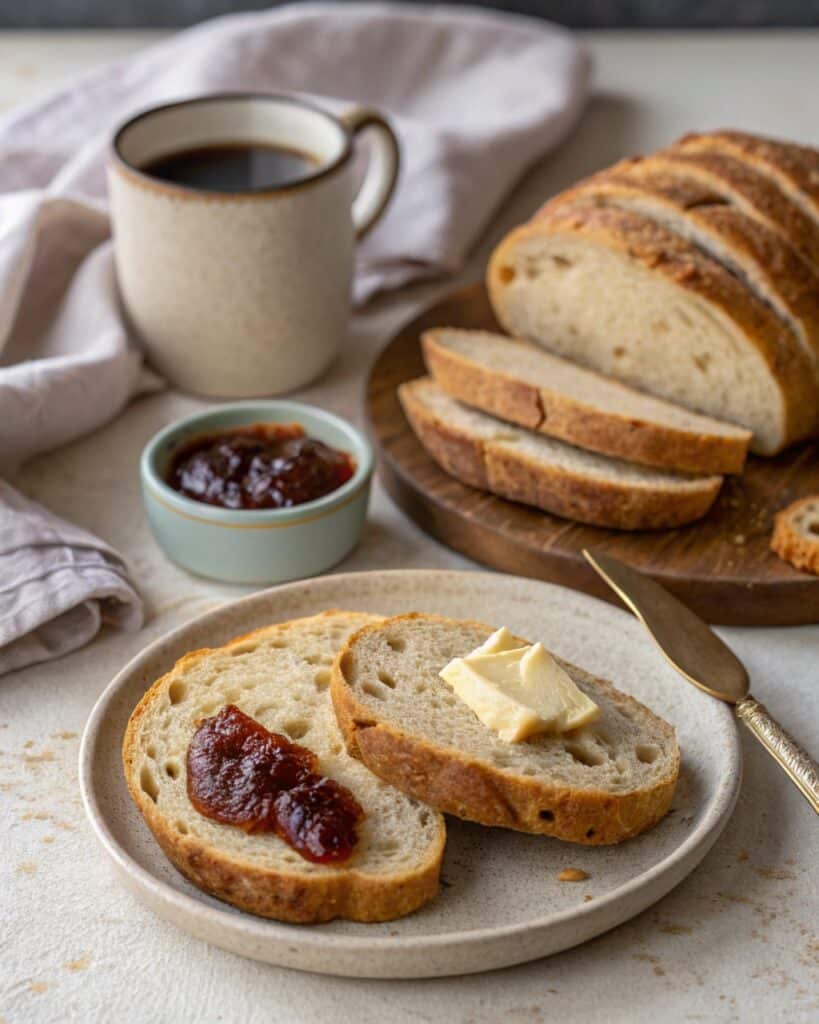
From breakfast toast to hearty dinner slices
This einkorn sourdough bread recipe makes a versatile loaf with a nutty depth that pairs beautifully with both sweet and savory toppings. Its soft, slightly open crumb and crackly crust make it a quiet centerpiece whether you’re serving guests or simply enjoying a warm slice in your kitchen with coffee.
Morning rituals:
One of my favorite ways to serve this bread is toasted with salted butter and a drizzle of honey. The mild sourdough tang complements the sweetness, and einkorn’s rich flavor works well with toppings like almond butter, tahini, or jam. If you love breakfast bakes like I do, you’ll find this loaf just as comforting as the flavors in my Bisquick banana bread recipe.
Midday and dinner pairings:
At lunch, it’s perfect for sandwiches. The bread holds structure but stays tender, making it great for avocado toast, grilled cheese, or tomato-and-mozzarella stacks. For dinner, try serving thick slices alongside soups or salads. Einkorn’s flavor is subtle but earthy—it pairs beautifully with lentil soup, roasted vegetables, or herbed olive oil.
When warmed slightly, the bread is almost buttery on its own. For a holiday meal, serve it like marble rye—cut into rustic wedges and topped with flaky salt.
Storage tips:
This bread keeps well for 2–3 days in a linen bag or wrapped in a clean dish towel. Avoid plastic, which softens the crust too much. To refresh, just toast slices or pop the whole loaf into a 350°F oven for 10 minutes.
For more creative serving ideas, many einkorn bakers like to try toppings like whipped ricotta, fig preserves, or herbed cream cheese. You’ll find some fresh pairings like these on GreatyRecipes’ sourdough guide, where traditional meets modern pantry twists.
Nutrition of Einkorn Sourdough Bread
Why einkorn is more than just another flour
Einkorn sourdough bread isn’t just a throwback to ancient grains—it’s a nourishing, digestible alternative to modern wheat bread. This loaf offers balanced nutrition and a softer impact on your gut, making it a smart choice for those looking for natural, whole-grain options without sacrificing flavor or texture.
Digestibility and gluten content:
Einkorn contains gluten, but it’s a different structure than the gluten found in modern wheat. It’s weaker and more water-soluble, which means many people with gluten sensitivity (not celiac disease) find it easier to digest. When fermented slowly—as in this einkorn sourdough bread recipe—the wild yeast and bacteria break down even more of the gluten and phytic acid, improving bioavailability.
Nutrient profile per slice (approx. based on 1/10 of loaf):
| Nutrient | Amount |
|---|---|
| Calories | 160 kcal |
| Protein | 5 g |
| Fat | 1 g |
| Carbohydrates | 32 g |
| Fiber | 3 g |
| Iron | 8% DV |
Why einkorn stands out:
Compared to modern wheat, einkorn has:
- Higher levels of lutein and beta-carotene (antioxidants)
- More protein and essential amino acids
- Lower glycemic impact
It’s a nutrient-dense grain that brings richness without heaviness—something I also love about recipes like this cranberry walnut bread where grains and fruit work together beautifully.
For a broader breakdown of how sourdough supports gut health, check out GreatyRecipes’ article on sourdough digestion, which explores fermentation and prebiotics in more detail.
Frequently Asked Questions About Einkorn Sourdough Bread
Can I use einkorn flour for sourdough bread?
Yes, einkorn flour works wonderfully for sourdough bread. Although it behaves differently from modern wheat flours, it’s perfect for slow fermentation. You just need to handle it gently—einkorn has a weaker gluten network, so over-kneading isn’t necessary.
How to make einkorn sourdough bread?
To make einkorn sourdough bread, mix whole grain einkorn flour, water, salt, and a sourdough starter. Allow time for a bulk fermentation, shape the dough gently, cold-proof overnight, and bake in a hot Dutch oven. You can follow the full step-by-step process in the recipe above for consistent results.
Yes, einkorn’s mild nutty taste and soft texture are great for basic sourdough loaves. You’ll notice a more tender crumb and richer taste than modern wheat, making it a favorite for many traditional bakers.
Can you make sourdough bread with einkorn flour?
Yes, einkorn flour is a fantastic option for making sourdough bread. It ferments well, offers a rustic texture, and contains higher nutrients compared to modern wheat. Just adjust your hydration and skip the aggressive kneading—it’s all about patience.
What is einkorn sourdough bread?
Einkorn sourdough bread is a naturally leavened loaf made from einkorn wheat, the oldest cultivated wheat in the world. It’s more nutritious, easier to digest, and delivers a rich, mildly sweet flavor with a golden hue. This type of bread combines ancient grain wisdom with modern sourdough technique.
Conclusion
Baking this einkorn sourdough bread recipe is like stepping back in time with your hands in the present. You get all the earthy goodness of an ancient grain, gently fermented into a loaf that feels alive with flavor and memory. From the tender crust to the warm aroma, it’s a bread that speaks of care and calm.
When I bake this bread, I remember Kyoto and how my grandmother quietly worked the dough while telling stories. And here in California, it still feels like home—especially when my kitchen fills with that familiar scent.
Whether you’re new to baking or ready to try ancient grains, einkorn sourdough is a beautiful way to bake something deeply nourishing. And if you’re curious to try more, recipes like my spoon bread or date nut bread are lovely ways to continue your homemade journey.
Print
Einkorn Sourdough Bread Recipe: A Simple, Honest Loaf Full of Flavor
- Total Time: 18 hrs (includes proof)
- Yield: 1 loaf 1x
- Diet: Vegetarian
Description
This einkorn sourdough bread recipe features whole grain einkorn flour for a nutty, rich, and easy-to-digest artisan loaf. Perfectly crusty and soft inside, it’s simple to make at home.
Ingredients
500 g whole grain einkorn flour
325 g filtered water
100 g active sourdough starter
9 g sea salt
Optional: 1 tsp honey or 1 tbsp olive oil
Instructions
1. Feed your sourdough starter 6–8 hours ahead.
2. In a bowl, mix flour, water, and starter. Let rest for 45 minutes.
3. Add salt, mix gently.
4. Bulk ferment 4–5 hours at room temperature. Fold dough gently hourly.
5. Shape dough, rest 30 minutes.
6. Place in banneton, cover, refrigerate 8–12 hours.
7. Preheat oven to 475°F with Dutch oven inside.
8. Score loaf, bake 25 mins covered + 15–20 mins uncovered.
9. Cool at least 2 hours before slicing.
Notes
Hydration may vary slightly depending on your flour.
Handle dough gently—einkorn doesn’t need strong kneading.
Keeps well for 2–3 days in a linen bag. Freeze sliced for longer storage.
- Prep Time: 30 mins
- Cook Time: 45 mins
- Category: Bread
- Method: Baking
- Cuisine: Traditional
Nutrition
- Serving Size: 1 slice
- Calories: 160
- Sugar: 0g
- Sodium: 200mg
- Fat: 1g
- Saturated Fat: 0g
- Unsaturated Fat: 1g
- Trans Fat: 0g
- Carbohydrates: 32g
- Fiber: 3g
- Protein: 5g
- Cholesterol: 0mg
